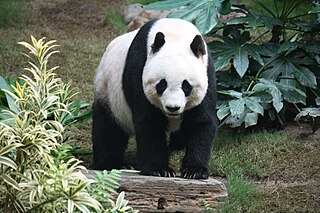A giant panda is a mammal with large black patches around the eye, ears and across its round body. It looks like a bear but is mainly a plant eater. The Chinese name for the panda is (Daxiongmao) which means large bear. A giant panda can weigh up to 330 pounds (150 kilograms) that is almost double that of an adult.
Habitat
The giant panda’s natural habitat is high up in the mountains of central China. However humans started to clear mountain forests as their population increased. They did not realize how dangerous it would be for giant pandas and other animals.
Food
Pandas eat most parts of a bamboo plant including the stalk, leaves and young shoots. In a day pandas eat about 26- 33 pounds (12 to 15 kilograms) of bamboo. Some giant pandas eat up to 44 pounds (20 kilograms) of bamboo in a day. That’s at least 10 times as much food as a person eats in a day. Pandas are perfectly adapted for eating bamboo. The front paws have a unique extra grip that allows them to eat a stalk of bamboo firmly. Pandas also have very big molars or back teeth - five times the size of a human molar.
Predators and Poaching
People and hunting animals like snow leopards and wolves are the largest predators of pandas. People harm pandas by hunting them for their fur. They also believed that panda skins have magical powers.
Population
Giant pandas are endangered mammals. It’s hard to tell exactly how many giant pandas live in the wild because they live alone.
To get a sense of how few pandas are there in this world, think of it this way: There are 1,000 giant pandas and more than 6 billion people in the world. This means for every 6 million people on earth there is only one giant panda.
How can we help them?
Become a member of an organization like WWF or Panda Trust.
Adopt a Panda - When you adopt a panda, it does not come to live with you. Instead you send money to help care for a panda in a zoo, reserve or breeding station.
Don’t harm their habitat by cutting down trees and throwing trash in the mountains and forests.







